|
Feed budgeting in the green
period is important to
ensure grain supplementation
will meet the flock
objectives. The break of
season is a crucial time for
many ewe flocks on annual
pastures as the quality and
quantity of dry feed is very
low and the emerging green
feed will usually need to be
supplemented to meet animal
energy requirements. Pasture
is growing very quickly and
growth rates can change over
night due to soil moisture
and temperature.
It is also important that the
pasture available
is assessed
correctly as pasture
can be deceptive in its
quantity and quality. Refer
to the pasture
photos in the tools
for managment section to
check your estimates.
The feed intake from
pastures varies with the
quality and the height of
the pasture.
The general steps for feed
budgeting at any time of the
year are;
1.
What they can eat - What
they require = surplus
or deficit of
energy
2.
If they aren't getting
enough energy then how
much to feed to meet the
requirement.
It is important to remember
that the energy requirements
of sheep vary with the feed
they are eating, the amount
of grazing they are doing to
find the feed and their
current status of nutrition
and whether they are dry,
pregnant or lactating.
The tables presented below
are general values
only. It is important
that these are used only as
a guide and that regular
condition scoring of the
flock is the best way to
tell if the feeding rates
are adequate for their
needs.
Step 1. What they Need
Using either Table 1a. or 1b.
select the column for the
frame size and row for the
pregnancy status of the
flock, finding the value for
maintenance energy required
in MJ/day.
These values will vary
slightly depending on the
quality of paddock feed
and supplement the ewes are
eating as well as the
weather conditions and
terrain of the paddock and
the age of the
ewe (this table assumes
ewes have an average diet
of 75%
digestibility and are
on sloping terrain with 30%
sub clover in the
pasture. For other
situations please refer to
Grazfeed).
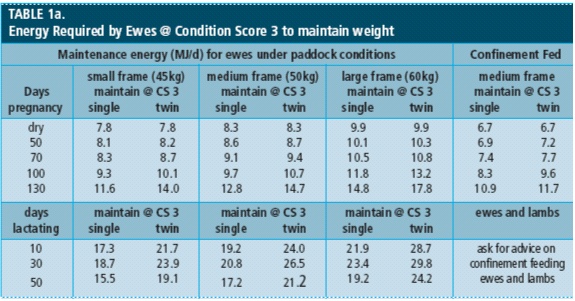 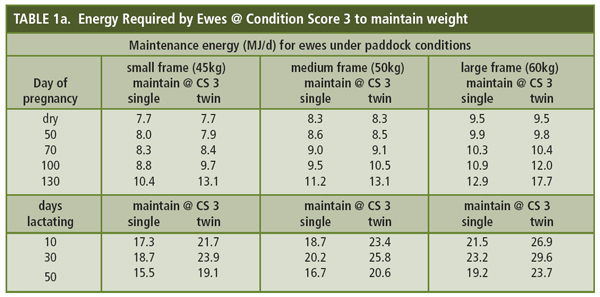
Example: medium frame ewes at
condition score 3 with twins
at day 100 of pregnancy need
approximately 10.5
MJ/day to maintain their
condition.
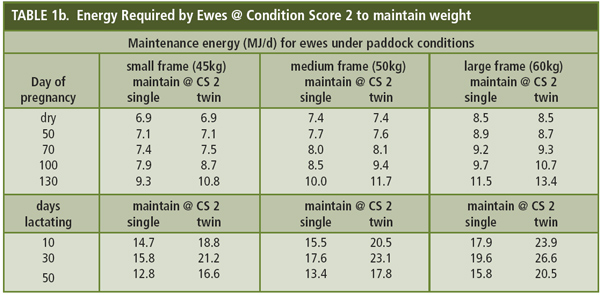
Step 2. What
they can eat
Using Table 2 a, b or c
identify the estimated
metabolisable energy (MJ)
intake from GREEN
paddock feed. Use
Table 2a for high quality
feed and Table 2b for medium
quality feed and Table 2c
for low quality feed.
View on line FOO photos in
the pasture
photo section or
order the lifetimewool FOO
photo Gallery for
south eastern Australian
pastures.
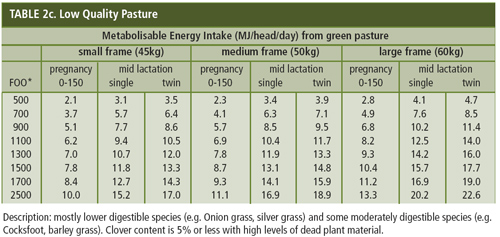
Example: The ewes in
step 1. are grazing high
quality pastures of green
500 FOO (table 2a).
This means they can eat
approximately 4.2
MJ/day.
Step 3. Losing or Gaining
Weight?
This is calculated by
subtracting the results of
Step 1 from the results of
Step 2, that is, what they
can eat minus what they
need. This is then either a
surplus and ewes will
increase in condition,
or a deficit and ewes will
lose condition. Table 3
shows the deficit or surplus
in terms of grams per
head per day and in change
in condition score in 30
days for each frame size.
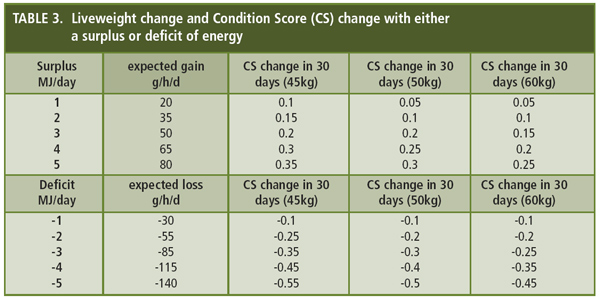
Example: The ewes from
Step 1 (need 10.5MJ/d) and
Step 2 (can eat 4.5
MJ/d) have a deficit
of 6MJ/d (10.5
-4.5MJ). This means
the ewes will be
losing about 150gms
per head per day or 0.6 of a
condition score over a
month. This is higher than
the recommended weight loss
allowed for pregnant
ewes. At day 100 it is
recommended that the ewes be
gaining on green feed.
This would require at least
1500 FOO by lambing (see guidelines
for High Rainfall Zone).
Step 4 How much
to feed?
Use the Table below
(from Managing Sheep in Dry
Times Bulletin
DAFWA) to obtain an
estimate of the energy value
of the feed expected to be
fed. We suggest that
feeds are tested as
they can
be variable, especially
hays and silage.
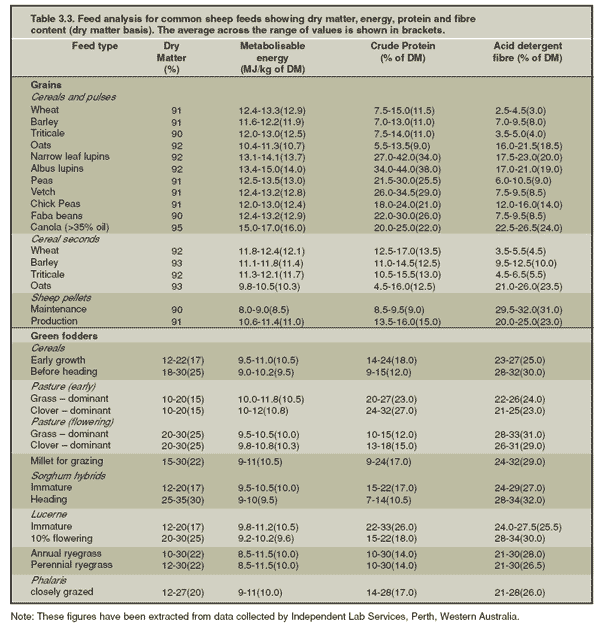
Step 5: Determine how much
feed to offer
Once a target condition for
the ewe flock and how much
energy is required to meet
that target been decided,
and the energy value of the
feedstuff determined you
need to calculate how much
feed to offer.
Ewes in energy deficit:
Use the table below: use the
1st column to identify the
quality of the feed (13
MJ/kg), read across until
the approximate deficit
amount is found (2MJ), then
follow the column upwards to
read off the feeding rate
(0.5kg).
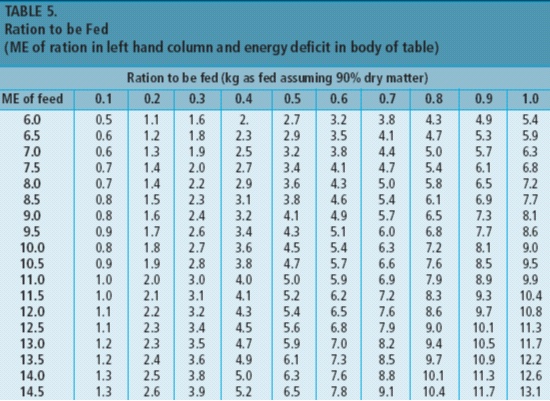
OR
Divide the deficit
(MJ/day) by the energy value
of the feed (MJ/kg).
This gives the number of
kilograms per day to be fed.
For example if ewes need
6MJ/d. Using barley at
13MJ/kg they require 6/13 =
0.46kg of barley
These figures are expressed
in dry matter per kilogram
so it is important to
convert the amount to 'as
fed' kilograms which takes
into account the moisture
content of the feed.
To do this;
Divide the kg/head/day
to be fed by the dry matter
% from Table 4. This
is the weight to be fed out
in the paddock.
For example,
barley at 90% Dry Matter and
0.46kg/hd/d required:
0.46kg / 0.90 =
0.51kg/hd/day to be fed.
|